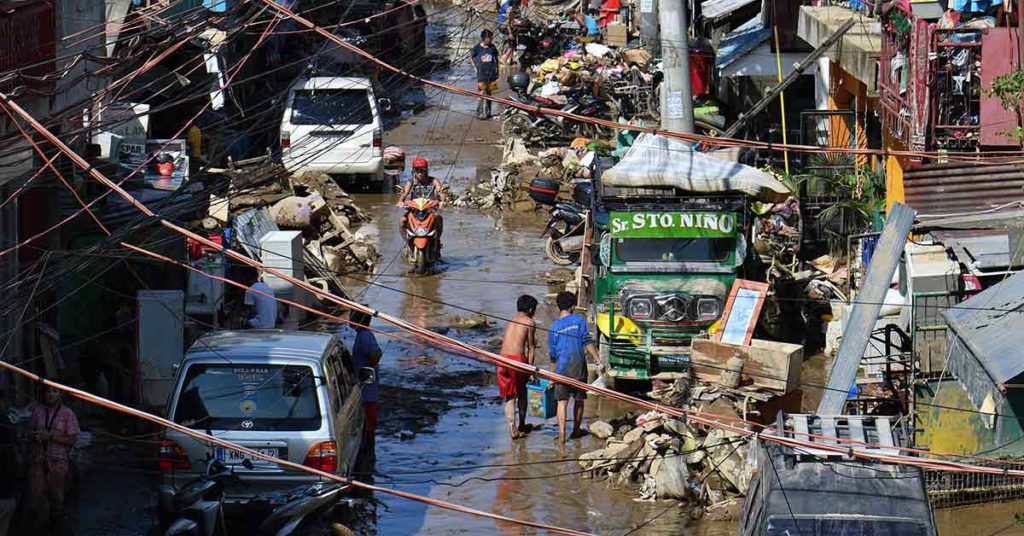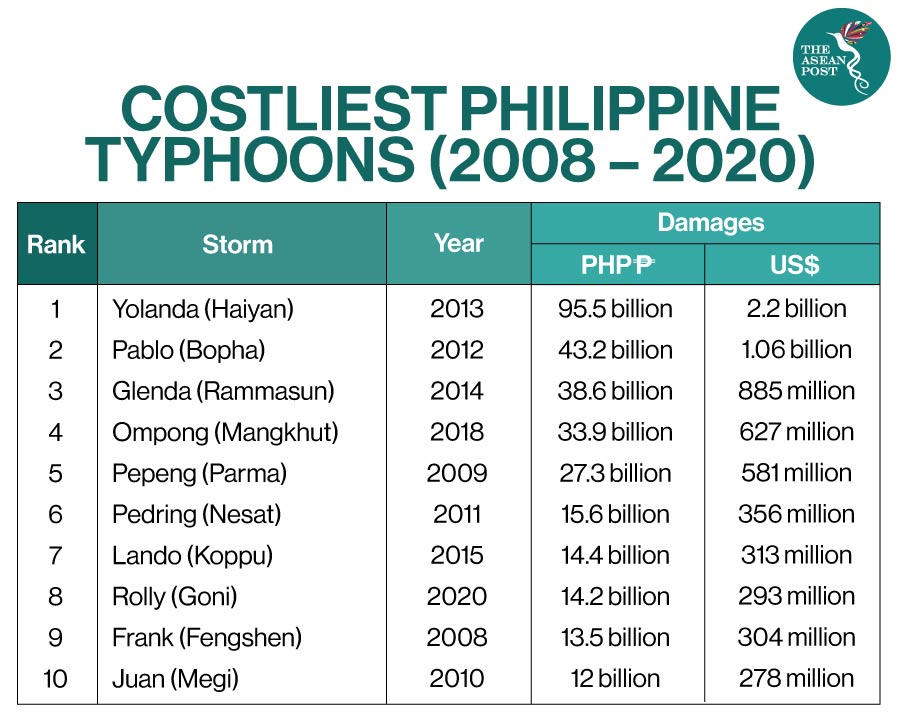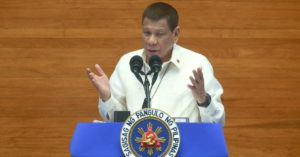
Being situated along the “Ring of Fire” and the “Typhoon Belt”, the Philippines is exposed to tropical storms and usually suffers from various natural disasters and calamities such as earthquakes, volcanic eruptions, and flooding.
Based on the 2018 World Risk Report, the Philippines ranked third in terms of disaster risk index, and the highest risks are those of earthquakes reported with 10 risk index points and tropical cyclones of 9.5 risk index points. Also, the country and its more than 109 million population are at constant risk of volcanic eruptions since it is located within the “Ring of Fire”, combined with coastal hazards such as typhoons, flooding, and the rising of sea levels.
Likewise, on average, at least 20 typhoons hit the Philippines annually and leave traces of destruction and desolation. All these taken together only prove that in terms of disaster vulnerability, the Philippines to a greater extent is indeed in a very vulnerable position.
Climate Change
Being located along the “Ring of Fire” and the “Typhoon Belt” is already a challenge for the Philippines in terms of reducing and curbing disaster vulnerability through disaster preparedness and mitigation. But this situation is even more challenging because of the multiplier effect of “climate change” and “man-made” activities that are destructive to the environment like illegal logging, irresponsible mining, irresponsible quarrying, and the like.
Even Philippine President Rodrigo Duterte agreed that to a greater extent the problem of climate change has contributed to the already vulnerable situation and proneness of the Philippines to natural calamities/disasters and had contributed much to the massive flooding that happened in Region 2 (Cagayan Valley) as one of the aftereffects of Typhoon Ulysses.
On 15 November 2020, during the situation briefing on the effects of Typhoon Ulysses, which was held at Tuguegarao City, Cagayan, Duterte said, “Ang problema ho talaga ngayon (the problem now) is that whether we accept it or not, itong (this) climate change. The warm climate boils the Pacific Ocean. There’s a lot of water vapor going upstairs and accumulating so much water, the rain, then it falls down. Talagang ang matamaan ngayon ‘yung mga (those that will be hit are the) populated areas nakokompormiso (are compromised)”.
In that briefing, Duterte also said that the Philippine government is demanding “climate justice” from developed countries as the Philippines suffers the most from climate change. He related that in one of the plenary sessions at the recently concluded 37th ASEAN Summit and Related Summits hosted by Vietnam and attended by the Association of Southeast Asian Nations (ASEAN) head of states.
He pressed developed nations to cut their carbon emissions in a bid to combat the effects of climate change. He also made a call to further enhance cooperation on disaster risk reduction management.
To note, the Philippines is in the top five countries fighting climate change along with Costa Rica, followed by Morocco, Portugal, and the United Kingdom (UK) – based on global research by Kalon Surf, a luxury surf resort in Costa Rica. The countries at the bottom of the list are the United States (US), Australia, South Africa, Indonesia, and Ireland.
Casualties
On the other hand, it’s a consolation that although the Philippines had recently experienced five typhoons (i.e., Quinta, Rolly, Siony, Tonyo, and Ulysses) in a row within more or less a month, and despite the combined enormous damage brought about by these five typhoons to the country, especially in terms of damage to material/property and the cost incurred to the Philippine economy, casualties are relatively low compared to the past.
According to reports, fatalities caused by natural disasters in the Philippines have been on the decline since a peak in 2013 during Typhoon Yolanda (Haiyan). There’s also more government risk reduction expenditure and attention since the time of Typhoon Yolanda.
For instance, the combined magnitude of casualties of Super Typhoons Rolly and Ulysses compared to Typhoons Ondoy and Haiyan (Yolanda) are much lower. The objective of the Philippine government is to have a zero-casualty index.
Typhoon Rolly has a death toll of 25, with 399 injured and 6 missing persons, while Typhoon Ulysses, based on the report by the National Disaster Risk Reduction and Management Council (NDRMMC), as of 21 November 2020 has a death toll of 73, with 68 injured, and 19 missing people across all affected areas. Typhoon Ondoy on the other hand, had a death toll of around 464, with 529 injured, and 37 missing persons.
Whereas Typhoon Yolanda had a death toll of 6,300, with 28,688 injured, and 1,062 missing persons. But according to unverified reports, these numbers were not indicative of the actual number of casualties. For instance, the former Commander of PNP Region 8 (Eastern Visayas) Police General Soria estimated that around 10,000 may have lost their lives during typhoon Yolanda. It can be recalled that the NDRRMC stopped releasing updated casualty numbers from Tacloban City and the rest of the Eastern Visayas after the death toll reached 4,011.
Moreover, given Duterte’s pledge to the affected communities and the Filipino nation that “no one will be left behind.” in the Philippine government’s on-going response, relief, rehabilitation, and recovery efforts, it is but imperative to look at the steps taken by the Philippine government moving forward in mitigating the after effects of the five typhoons that have hit the country.
Recent Developments
In response to the aftermath of the recent natural calamities that have hit that country, the Philippine government has established a National Government Administrative Center in New Clark City in Tarlac, providing for an “Integrated Government Center Outside the National Capital Region (NCR) in Case of Disaster through Executive Order (EO) No. 119, which was signed by President Duterte recently. The said EO also directs the whole government to establish satellite offices therein.
The rationale behind the EO is to ensure that government functions and operations in the event that Manila is affected by natural calamities, will not be impeded and can proceed as required. Likewise, due to the impact of the recent typhoons that struck the country on the island of Luzon, Duterte declared the entire Luzon under a “state of calamity.”
On 16 November, Duterte signed Administrative Order No. 35 authorising the extension of active hazard duty pay to all frontline human resources for health while the country is still in a “state of national emergency.”
Whereas, another EO was signed by Duterte to form a “Build Back Better Task Force” that would not only dispense a “science-based approach” in the rehabilitation and recovery efforts of the Philippine government but would also fast-track the distribution of assistance to victims of the last five typhoons that hit the country.
The task force is also mandated to provide immediate solutions to disaster rehabilitation and recovery in typhoon-affected areas and communities. This task force is chaired by the Department of Environment and Natural Resources (DENR) with the Department of Public Works and Highways (DPWH) as Co-Chair.
The Office of the President (OP) will oversee the task force and it will report to the President through Executive Secretary Salvador Medialdea. Other national agencies in the task force include the departments of Agriculture; Budget and Management; Social Welfare and Development; National Irrigation Administration; National Electrification Administration; and National Housing Authority, among others.
Law enforcement agencies like the Philippine Air Force, Philippine Navy, and Philippine Coast Guard and local government units (LGUs) will also be extending assistance to the task force when necessary.
According to Presidential Spokesperson Harry Roque, the task force is necessary so that there is a “more permanent body” to address and monitor the multifarious issues and concerns involved in the rehabilitation and recovery phase of typhoon-affected areas.
The task force will also focus on developing expertise on post-disaster rehabilitation and recovery of typhoon-hit areas since the proposed legislation to create the Department of Disaster Resilience (DDR) has yet to be enacted into law.
The House of Representatives has approved its version of the DDR bill but the said measure is still pending Senate approval.

The Philippine government will also implement a tree planting program as part of its reforestation efforts. This is integral to the government’s initiatives in preventing deadly floods whenever a typhoon or heavy rains hit the country. One way to implement the reforestation program is by making it mandatory for public transport cooperatives and individuals to commit a specific number of trees to be planted before acquiring a franchise or license.
This mandatory scheme was proposed by the Land Transportation Franchising and Regulatory Board (LTFRB), which is under the Department of Transportation (DOTr) in coordination with DENR and LGUs in identified areas where reforestation is necessary. This initiative will be implemented nationwide.
Duterte also vowed that the government will strengthen its forest protection efforts to fight illegal logging and illegal mining with the help of LGUs.
Conclusion
Thus far, it seems that the Philippine government is on track with the necessary steps to be taken moving forward in its recovery and rehabilitation efforts as it responds to the after effects of the devastation caused by the five typhoons that hit the country recently.
One of the main challenges for the Philippines is the exacerbated impact of climate change as seen by the increasing frequency and severity of natural disasters hitting the country recently. It is important for the Philippine government to place priority on the creation of “climate-resilient, integrated and sustainable communities and even infrastructures.”
Likewise, the Philippine government must also address the contradiction of land use policies that primarily place importance on socio-economic factors while failing to take into consideration disaster risk reduction issues and concerns. There should be a balance in this regard.
The Philippine government should also consider the implementation of a “no-build zone” policy in disaster risk and prone areas if it wants to be more effective in its disaster preparedness efforts. Thus, Congress must pass the proposed National Land Use Act, to ensure the sustainable and efficient use of the country’s land and physical resources. The bill proposes to harmonise sector-specific land-use policies and to institutionalise land use planning.
According to the National Economic Development Authority (NEDA), there’s a need to plan for the physical space of the country. Land-use policies must be clear on where and how much space to allocate for agricultural production to ensure food sufficiency; where and how much space for settlements development to meet housing demand; where to encourage the growth of industries to boost the economy and create jobs; and which areas should be protected for environmental sustainability.
Source: The ASEAN Post
https://theaseanpost.com/article/philippines-moving-forward-after-ulysses



